
Answer
473.7k+ views
Hint: A substance which has optical activity, is a substance which rotates the plane of plane polarized light. To know whether a compound is optical active we need to consider the property of chirality. By chirality we mean a carbon having 4 different groups attached to it. If we find any chiral centre, then that compound is optically active. With this approach, we can find out which of the compounds mentioned in the options are optically active.
Complete step by step answer:
Option A mentions the compound $\text{C}{{\text{H}}_{3}}\text{C}{{\text{H}}_{\text{2}}}\text{COOH}$ which has an IUPAC name of propanoic acid has a molecular structure of,
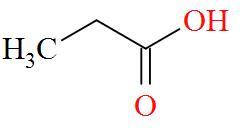
As per the definition, no carbon atom in propanoic acid is seen to be bonded to four different atoms or groups of atoms. Hence, propanoic acid is optically inactive in nature.
Option B mentions the compound $\text{HOOC - C}{{\text{H}}_{\text{2}}}\text{- COOH}$ also known as Malonic acid has a molecular structure of,
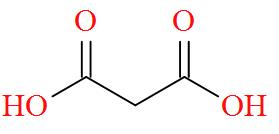
As per the definition, no carbon atom in Malonic acid is seen to be bonded to four different atoms or groups of atoms. Hence, Malonic acid is optically inactive in nature.
Option C mentions the compound $\text{C}{{\text{H}}_{\text{3}}}\text{CH(OH)COOH}$ which has an IUPAC name of 2-hydroxypropanoic acid, also known as lactic acid has a molecular structure of,
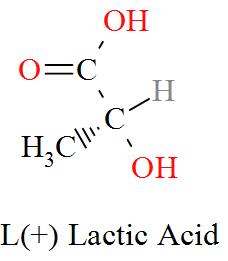
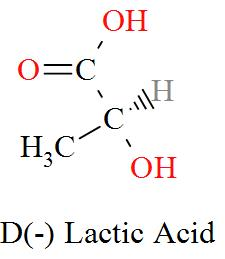
As per the definition, here we can see one carbon atom in Lactic acid is seen to be bonded to four different atoms or groups of atoms forming a Levo and a Dextro structure. Hence, Lactic acid is optically active in nature.
Option D mentions the compound $\text{C}{{\text{l}}_{\text{2}}}\text{CHCOOH}$ which has an IUPAC name of dichloroacetic acid has a molecular structure of,
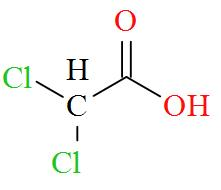
As per the definition, no carbon atom in dichloroacetic acid is seen to be bonded to four different atoms or groups of atoms. Hence, dichloroacetic acid is optically inactive in nature.
Therefore, the correct option is Option C.
Note: Therefore, we can say that chiral molecules are optically active, which implies that when a beam of plane polarized light passes through a chiral molecule. This will make sure that it interacts with the molecule in such a way that the angle of the plane of oscillation rotates.
Complete step by step answer:
Option A mentions the compound $\text{C}{{\text{H}}_{3}}\text{C}{{\text{H}}_{\text{2}}}\text{COOH}$ which has an IUPAC name of propanoic acid has a molecular structure of,

As per the definition, no carbon atom in propanoic acid is seen to be bonded to four different atoms or groups of atoms. Hence, propanoic acid is optically inactive in nature.
Option B mentions the compound $\text{HOOC - C}{{\text{H}}_{\text{2}}}\text{- COOH}$ also known as Malonic acid has a molecular structure of,

As per the definition, no carbon atom in Malonic acid is seen to be bonded to four different atoms or groups of atoms. Hence, Malonic acid is optically inactive in nature.
Option C mentions the compound $\text{C}{{\text{H}}_{\text{3}}}\text{CH(OH)COOH}$ which has an IUPAC name of 2-hydroxypropanoic acid, also known as lactic acid has a molecular structure of,


As per the definition, here we can see one carbon atom in Lactic acid is seen to be bonded to four different atoms or groups of atoms forming a Levo and a Dextro structure. Hence, Lactic acid is optically active in nature.
Option D mentions the compound $\text{C}{{\text{l}}_{\text{2}}}\text{CHCOOH}$ which has an IUPAC name of dichloroacetic acid has a molecular structure of,

As per the definition, no carbon atom in dichloroacetic acid is seen to be bonded to four different atoms or groups of atoms. Hence, dichloroacetic acid is optically inactive in nature.
Therefore, the correct option is Option C.
Note: Therefore, we can say that chiral molecules are optically active, which implies that when a beam of plane polarized light passes through a chiral molecule. This will make sure that it interacts with the molecule in such a way that the angle of the plane of oscillation rotates.
Recently Updated Pages
10 Examples of Evaporation in Daily Life with Explanations

10 Examples of Diffusion in Everyday Life

1 g of dry green algae absorb 47 times 10 3 moles of class 11 chemistry CBSE

What happens when dilute hydrochloric acid is added class 10 chemistry JEE_Main

What is the meaning of celestial class 10 social science CBSE

What causes groundwater depletion How can it be re class 10 chemistry CBSE

Trending doubts
Fill the blanks with the suitable prepositions 1 The class 9 english CBSE

Which are the Top 10 Largest Countries of the World?

How do you graph the function fx 4x class 9 maths CBSE

Who was the leader of the Bolshevik Party A Leon Trotsky class 9 social science CBSE

The Equation xxx + 2 is Satisfied when x is Equal to Class 10 Maths

Differentiate between homogeneous and heterogeneous class 12 chemistry CBSE

Difference between Prokaryotic cell and Eukaryotic class 11 biology CBSE

Which is the largest saltwater lake in India A Chilika class 8 social science CBSE

Ghatikas during the period of Satavahanas were aHospitals class 6 social science CBSE




